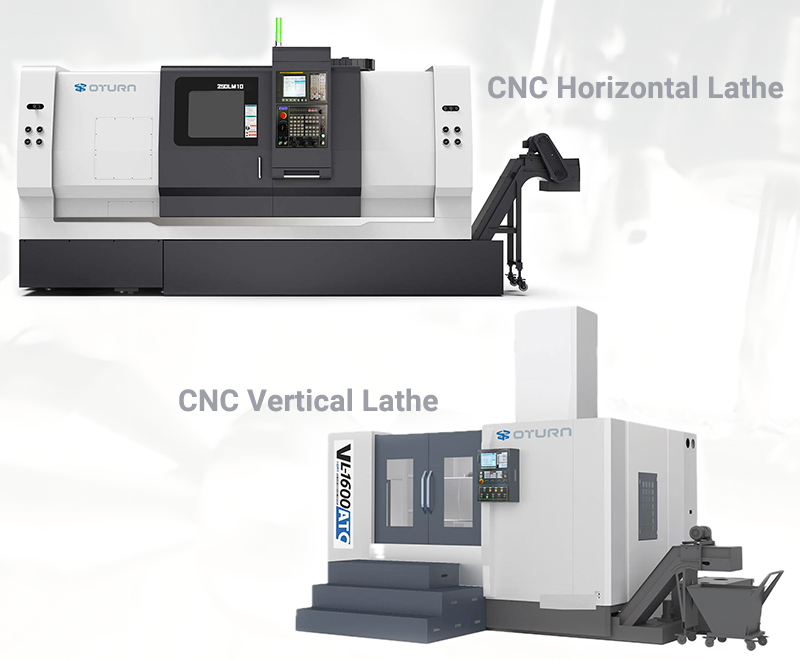CNC vertical lathe and CNC horizontal lathe are two core pieces of equipment in the metalworking industry. Their structural layouts, processing capabilities, and applicable scenarios differ significantly. The following systematic comparison focuses on structural design, processing characteristics, application scenarios, and maintenance costs, and offers selection recommendations based on actual cases.
I. Structural Layout and Core Design Differences
CNC horizontal lathes feature a horizontal spindle, with the workpiece typically held horizontally by a chuck or center. Their compact bed structure makes them suitable for small to medium-sized operations and space-constrained workshops. CNC horizontal lathes offer easy visibility of the machining process and convenient tool changes, making them ideal for machining shafts, wheels, and parts of medium to long length. In contrast, CNC vertical lathes feature a vertical spindle and a large turntable, with the workpiece placed horizontally on the workbench. This vertical design distributes the weight of heavy workpieces directly onto the bed, improving rigidity and load-bearing capacity, making them suitable for machining large-diameter and heavy-weight workpieces.
|
Vertical Lathe |
Horizontal Lathe |
|
|
Spindle Orientation |
Vertical spindle; workpiece horizontally clamped on a rotating worktable. | Horizontal spindle; workpiece clamped horizontally via chuck or centers. |
|
Floor Space |
Larger (requires space for hoisting), suitable for heavy-duty workshops. |
Compact, ideal for small to medium workshops with centralized operation zones. |
| Workpiece Clamping | Designed for large-diameter, heavy disc/ring-shaped parts (e.g., flanges, hubs). |
Optimized for long-axis parts (e.g., lead screws, bearings, pipes). |
II. Machining Capabilities and Performance Comparison
CNC Horizontal lathe have a relatively simple structure and utilize a multi-turret design, enabling automatic tool changes across multiple processes, effectively reducing non-turning time and improving production efficiency. They are suitable for high-precision machining of medium- and long-length shaft parts such as drive shafts, pump shafts, and bearing housings. Vertical lathes, on the other hand, offer exceptional rigidity and stability, making them suitable for machining the end-face, as well as the internal and external surfaces, of complex parts such as large-diameter workpieces, including automotive wheels, wind turbine blades, and heavy flanges. They offer high machining accuracy and excellent surface quality, making them particularly well-suited for high-load turning and interrupted turning.
|
Vertical Lathe |
Horizontal Lathe |
|
|
Machining Range |
- Ideal for large-diameter (>1000 mm) parts: face, outer/inner diameter machining. - Limitations: Less adaptable for long-axis parts, requiring multiple setups. |
- Excels in continuous outer diameter turning, deep-hole drilling, and thread turning. - Limitations: Struggles with oversized/heavy parts due to clamping challenges and gravitational deformation. |
| Precision & Efficiency | - Repeat positioning accuracy: ±0.0075 mm (X/Z axes). - Machining precision: IT6-IT7. - Multi-tool turret reduces non-turning time. |
- Surface roughness: Ra 0.8 μm for high-finish requirements. |
III. Application Scenarios and Industry Suitability
CNC horizontal lathe, due to their flexible structure and high machining efficiency, are widely used in automotive manufacturing, mechanical parts processing, and mass-produced shaft parts processing. Vertical lathes, with their excellent load-bearing capacity and machining performance, are ideal equipment for aerospace, wind energy equipment, and heavy machinery manufacturing. They particularly demonstrate significant advantages when machining large structural components and complex shapes.
| Vertical Lathe Applications | Horizontal Lathe Applications | |
|
Energy Equipment |
Wind turbine hubs, nuclear reactor flange face machining. | Steam turbine rotor shafts, pump body deep-hole machining. |
|
Construction Machinery |
Excavator slewing rings, hydraulic valve body boring. |
Hydraulic cylinder barrels, transmission shaft turning. |
| Rail Transit | High-speed rail brake discs, wheel set mass production. |
Axles, bearing housing precision machining. |
| Mold Manufacturing | Large injection mold cavity finishing. |
Small mold inserts, electrode turning. |
IV. Selection Advice and Cost Considerations
When selecting a CNC lathe, companies should conduct a comprehensive analysis based on workpiece size, shape, and machining requirements. For heavy, wide-diameter workpieces requiring multi-faceted machining, a vertical lathe is more suitable, ensuring both rigidity and quality. Conversely, for long-axis workpieces and those requiring more space, a horizontal lathe is preferred due to its high efficiency and flexibility. Considering cost and maintenance factors, CNC horizontal lathes offer a simpler structure, easier maintenance, and relatively lower energy consumption. Vertical lathes have higher procurement and maintenance costs, but offer better adaptability to heavy-duty work.
| Vertical Lathe | Horizontal Lathe | |
|
Selection Criteria |
1. Workpiece diameter >800 mm or weight >3000 kg. 2. Multi-face machining (e.g., face + bore + milling). |
1. Workpiece length-to-diameter ratio >5:1 (e.g., long shafts, pipes). 2. High surface finish or deep-hole machining. |
|
Purchase Cost |
Higher (approx. ¥1.5–3 million). |
Lower (approx. ¥0.5–1.5 million). |
| Maintenance Cost | Higher (complex replacement of heavy components). |
Lower (simple structure, easy maintenance). |
| Energy Consumption | Higher (high-power spindle + multi-axis systems). |
Lower (medium/low-power spindle). |
V. Conclusion
CNC horizontal and vertical lathes each have their own advantages. Choosing the right CNC machine for each specific machining requirement can help improve both production efficiency and machining quality. Vertical lathes, with their high load capacity, are suitable for large, complex parts, while CNC horizontal lathes, with their efficient machining capabilities, are suitable for a wide variety of small and medium-sized parts. Scientifically and rationally configuring equipment is a crucial prerequisite for modern manufacturing companies to move towards intelligent and efficient production.
Post time: Oct-17-2025








